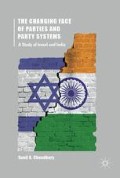Abstract
Sharing common culture and history, state formation in India followed similar historical trajectory but different political patterns as that visible in the case of Israel. With the foundation of Indian National Congress in 1885 as political pioneer, the struggle for independence took great momentum. The initiatives and efforts of Moderates, Extremists and Mahatma Gandhi finally facilitated the transition of the nation from a colony to an independent entity in 1947. The constitution-making process in India involving different ideological shades finally presented a consensual model of accommodation and inclusion in 1950.
Access this chapter
Tax calculation will be finalised at checkout
Purchases are for personal use only
Notes
- 1.
The primitive richness of Indian history could be traced to the Hindu scriptures called Vedas [the Rig-Veda, Sama-Veda, Yajur-Veda and Atharva-Veda] and Upanishads.
- 2.
Bengal was partitioned by the British into East Bengal and West Bengal—the former had the Muslim majority, whereas the latter had Hindu dominance. The British explained the partition as administrative expediency, but it came to be characterized as a communal polarization between the two communities—Hindus and Muslims.
- 3.
The present Punjab in India in its earlier undivided form was called Panjab.
- 4.
Satyagraha was Gandhian tool of protest and resistance, which means ‘holding firmly to truth’.
- 5.
A place in Gorakhpur, Uttar Pradesh , where an angry mob put on fire the police station by killing all the policemen. Gandhi was so perturbed with the incident that he called off the entire movement.
- 6.
N C Kelkar, H S Suhrawardy, Subhash Chandra Bose besides M N Roy and C R Das constituted the pro-changers group.
- 7.
The Cawnpore (now Kanpur) Conspiracy was lodged against the leading Communist leaders of the time in March 1924, like M N Roy , S A Dange and others on the charge that they were attempting to overthrow the Raj through violent revolution. Similarly, the Communist leaders were also charged under Meerut Conspiracy case in 1929.
- 8.
British India comprised 11 British Provinces and 565 Princely States. Total membership of the Constituent Assembly was 323. Members of the Constituent Assembly were elected from among the British Provinces and Princely States on the basis of property and education.
- 9.
Some of the Gandhians in the Constituent Assembly were Rajendra Prasad, J B Kripalani, B Pattabhi Sitaramayya; the Socialists comprised Somnath Lahiri, Renuka Ray, Shibban Lal Saxena; the Liberals included Jawaharlal Nehru , Sardal Patel, Maulana Azad, K M Munshi, Minoo Masani and Alladi Krishna Swami Iyer.
- 10.
The words socialist and secular got added to the Preamble of the Constitution by 42nd Amendment in 1976.
- 11.
The Constitution now has 21 parts [4 new sub-parts got added, 1 repealed, totalling 25 in number], 12 schedules [4 new schedules were added to 8, making 12] and 395 articles [53 sub-articles got added, leading to 448 articles]. Addition with sub didn’t change the primary number of the parts and articles.
References
Baxter, C. (1971). The Jana Sangh: A biography of an Indian political party. New York: Oxford University Press.
Sunil Kumar. (2001). Communalism and secularism in Indian politics: Study of BJP. Delhi/Jaipur: Rawat Publications.
———. (2010). Pluralism and a second democratic upsurge. Eternal India, 2 (6), 95–109.
Author information
Authors and Affiliations
Rights and permissions
Copyright information
© 2018 The Author(s)
About this chapter
Cite this chapter
Choudhary, S.K. (2018). Indian National Congress: From a ‘Safety Valve ’ to the Political Pioneer of Freedom Struggle. In: The Changing Face of Parties and Party Systems . Palgrave Macmillan, Singapore. https://doi.org/10.1007/978-981-10-5175-3_4
Download citation
DOI: https://doi.org/10.1007/978-981-10-5175-3_4
Published:
Publisher Name: Palgrave Macmillan, Singapore
Print ISBN: 978-981-10-5174-6
Online ISBN: 978-981-10-5175-3
eBook Packages: Political Science and International StudiesPolitical Science and International Studies (R0)

